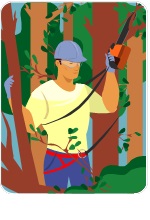 Hiring a Tree Care Expert - June 26, 2013 Jeff Schalau, Agent, Agriculture & Natural Resources University of Arizona Cooperative Extension, Yavapai County From time to time, readers have asked me to recommend various types of horticultural professionals. As a public servant and in fairness, I cannot endorse one business over another. So, my approach has been to educate consumers about tree care, have them ask some key questions when they visit with potential contractors, and make their decision based on the interview and the contractor’s credentials. Mature trees are often focal points that define the landscape and accentuate other nearby features. Healthy, well-cared-for trees can contribute up to 15% of your property value. Try this: look at your landscape, noticing all the amenities that your trees provide: shade, shape, pattern, seasonal change, habitat, etc. Now, look again and imagine that same landscape without trees. This should give some indication of what your trees are worth and what may be an appropriate amount to spend on them if they need attention. In the landscape industry, tree care professionals are called arborists. Arborists provide services such as pruning, removal, emergency care, planting, preventative maintenance, pest control, and more. As with any skilled trade, some practitioners are self-proclaimed experts while others have credentials, certifications, or licenses to validate their claims. Beware of those that solicit work door-to-door, have vehicles without company identification, or cannot produce a business card with an address and phone number. To begin selecting an arborist, ask the arborist to come on-site and give an estimate. When the prospective arborist arrives, ask them for professional qualifications, to provide references, and if they are insured. If references are available, you may visit and inspect the work done. You may also talk to the property owner to confirm their satisfaction. Professional qualifications/certifications do not always guarantee high quality work, but it does demonstrate a basic level of professional capability and commitment to the field. The International Society of Arboriculture (ISA) offers two level of certification: Certified Tree Worker and Certified Arborist. Certification requires passing a test and completing regular continuing education. A list of ISA Certified Arborists in your area can be obtained from their web site (www.isa-arbor.com). The National Arborists Association (NAA) is comprised of tree care service firms. The NAA has developed standards for pruning, cabling, and other tree care techniques. The NAA also has a web site (www.natlarb.com). The American Society of Consulting Arborists (www.asca-consultants.org/) is composed of practicing arborists who specialize in advising, making appraisals, and providing court testimony. Many arborists are members of one or more of these professional organizations. Arborists should be able to provide a written estimate that details the work to be done. Obtain estimates from two or more companies making certain that work to be done is comparable. Low bid is usually not the most important consideration. Assess the arborist's skills by asking them about techniques they would use. If they use the words "top" or "topping" to describe their pruning techniques, you may want to consider hiring someone else. Qualified arborists use terms like "crown reduction" or "drop crotching" to describe tree height reduction techniques. You may also want to enquire about the potential need for future maintenance, given the work you are currently outlining. Safety and liability are important concerns. Ask the arborist for a certificate of insurance (including proof of liability for personal and property damage). You should also confirm that the policy is current. This information can be provided at no cost to you or the arborist. Under some circumstances, you may be held financially responsible if an uninsured worker is hurt on your property or if damage is done to a neighbor's property. After selecting an arborist, get the details written into a contract. This can go far to prevent misunderstandings and ensure that the work performed is to the standards you expect. There is not enough room here to detail every element that should be included in a contract. The University of Arizona Cooperative Extension Publication "How to Hire a Tree Expert" by Lucy Bradley has this information and more. This publication is available on-line at: cals.arizona.edu/pubs/garden/az1003.pdf or at your local University of Arizona Cooperative Extension Office. Follow the Backyard Gardener on Twitter – use the link on the BYG website. If you have other gardening questions, call the Master Gardener help line in the Camp Verde office at 928-554-8999 Ext. 3 or e-mail us at cottonwoodmg@yahoo.com and be sure to include your name, address and phone number. Find past Backyard Gardener columns or provide feedback at the Backyard Gardener web site: http://cals.arizona.edu/yavapai/anr/hort/byg/. |